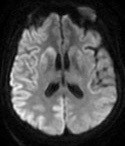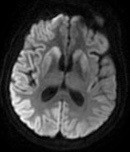Session Information
Date: Wednesday, June 7, 2017
Session Title: Cognitive Disorders
Session Time: 1:15pm-2:45pm
Location: Exhibit Hall C
Objective: To describe an unusual case of sporadic Creutzfeld Jacob Disease (CJD) that initially presented with ascending tingling of lower extremities.
Background: Prion diseases are fatal neurodegenerative diseases caused by misfolded proteins. CJD is the most common prion disease, it is characterized by rapidly progressive dementia, extrapyramidal symptoms, ataxic gait, myoclonus, and visual changes. CJD falls into four categories: sporadic (sCJD), familial (fCJD), iatrogenic (iCJD) and variant (vCJD). sCJD is the most common form, representing 85% of cases worldwide; incidence ranges between 0.5 and 1.5 cases per million inhabitants per year. vCJD initially presents with sensory symptoms, an earlier age of onset, has pulvinar involvement, and a longer life expectancy than sCJD.
Methods: We present a 57-year-old woman with acute ascending tingling in her lower extremities starting in the left foot and progressing to both legs and the left arm. Her gait rapidly declined and was wheel chair bound by week 4. By week 6 she had dystonic posturing of her left hand, severe truncal ataxia, precipitous cognitive decline, hallucinations, and myoclonic jerking. She progressed to develop autonomic instability with tachypnea, tachycardia, fluctuating blood pressures, and akinetic mutism by week 10. Brain MRI showed increased signal in the head of caudate, putamen, parietal, temporal and occipital cortex (left brain more affected than right) that progressed with her clinical deterioration. EEG showed diffuse slowing and progressed to periodic sharp wave complexes. CSF analysis showed tau protein of 8400, protein 13-4-4 was not assessed due to bloody sample. Her clinical, electrographic, and imaging patterns were consistent with sCJD. Patient died at week 16, and the brain is being autopsied at this time.
Results: Given her age of onset, duration of illness, rapid dementia, myoclonus, extrapyramidal symptoms, autonomic dysfunction, EEG findings, and absence of bilateral pulvinar high signal in MRI: this case is probably a sCJD rather than vCJD.
Conclusions: This is rare association between early acute sensory disturbances and sCJD. Although concurrent manifestation of these conditions can be accidental, the clinical progression of predominantly left sided symptoms and more severe right sided brain involvement seen on MRI is unlikely to be coincidence. When assessing a patient for CJD the need for a clear neurologic history is paramount.
To cite this abstract in AMA style:
R. Hanumanthu, A. Alchaki, A. Nyaboga, H. Ghuman, J. Chen, E. Feinstein. An unusual case of sporadic Creutzfeld Jacob disease presenting as acute neuropathy [abstract]. Mov Disord. 2017; 32 (suppl 2). https://www.mdsabstracts.org/abstract/an-unusual-case-of-sporadic-creutzfeld-jacob-disease-presenting-as-acute-neuropathy/. Accessed April 4, 2025.« Back to 2017 International Congress
MDS Abstracts - https://www.mdsabstracts.org/abstract/an-unusual-case-of-sporadic-creutzfeld-jacob-disease-presenting-as-acute-neuropathy/


